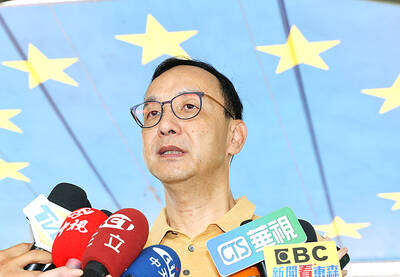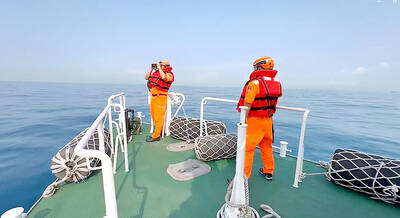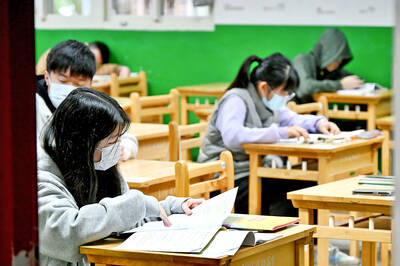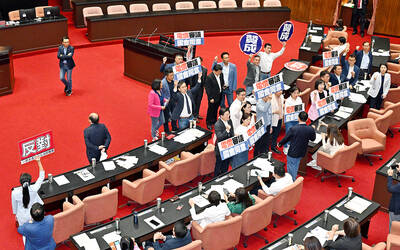The US kept the military well-informed of the missile tests that China was to launch prior to the 1996 Taiwan Strait crisis, KMT Legislator Nelson Ku (
In the book Admiral Ku the Helmsman, Ku said that the missile tests did happen in March 1996, as the US had predicted.
"The information was provided to us in October 1995, during my visit to the US. The US predicted that China would launch some kind of military action to influence the [Taiwan's] presidential elections the following March. They said China was likely to launch a missile every two to three days into the Taiwan Strait and that such missile tests would last for quite some time," Ku wrote.
"The US asked us to take such military intimidation seriously. I reported the message to my superiors after returning to the country.
"The missile tests did happen in the lead-up to the presidential elections as predicted by the US," Ku wrote.
Ku commanded the navy between 1994 and 1997. He is the first of the military leaders who were in command during the crisis to make public the flow of information between the US before and during the crisis.
At a press conference held yesterday to mark the release of the book Ku gave more details.
"Because of the information provided by the US, the military had enough time to prepare for the missile tests," he said.
"We did not worry too much about the missile tests since we knew in advance that they were aimed at influencing our presidential elections. We did not think they would develop into a war," he said.
"The way in which the tests were conducted met our expectations. The only thing out of ours or China's expectations was that the tests did not scare people away from voting for [former president] Lee Teng-hui (
The Taiwan Strait Crisis led to greater trust between Taiwan and the US and some changes in the Sino-US relations, he said.
"The US does not want to see a war in the Taiwan Strait. They take it as their obligation to prevent Taiwan from suffering from any aggression," he said.

GOOD DIPLOMACY: The KMT has maintained close contact with representative offices in Taiwan and had extended an invitation to Russia as well, the KMT said The Chinese Nationalist Party (KMT) would “appropriately handle” the fallout from an invitation it had extended to Russia’s representative to Taipei to attend its international banquet last month, KMT Chairman Eric Chu (朱立倫) said yesterday. US and EU representatives in Taiwan boycotted the event, and only later agreed to attend after the KMT rescinded its invitation to the Russian representative. The KMT has maintained long-term close contact with all representative offices and embassies in Taiwan, and had extended the invitation as a practice of good diplomacy, Chu said. “Some EU countries have expressed their opinions of Russia, and the KMT respects that,” he

An increase in Taiwanese boats using China-made automatic identification systems (AIS) could confuse coast guards patrolling waters off Taiwan’s southwest coast and become a loophole in the national security system, sources familiar with the matter said yesterday. Taiwan ADIZ, a Facebook page created by enthusiasts who monitor Chinese military activities in airspace and waters off Taiwan’s southwest coast, on Saturday identified what seemed to be a Chinese cargo container ship near Penghu County. The Coast Guard Administration went to the location after receiving the tip and found that it was a Taiwanese yacht, which had a Chinese AIS installed. Similar instances had also

CHANGES: After-school tutoring periods, extracurricular activities during vacations or after-school study periods must not be used to teach new material, the ministry said The Ministry of Education yesterday announced new rules that would ban giving tests to most elementary and junior-high school students during morning study and afternoon rest periods. The amendments to regulations governing public education at elementary schools and junior high schools are to be implemented on Aug. 1. The revised rules stipulate that schools are forbidden to use after-school tutoring periods, extracurricular activities during summer or winter vacation or after-school study periods to teach new course material. In addition, schools would be prohibited from giving tests or exams to students in grades one to eight during morning study and afternoon break periods, the

AMENDMENT: Contact with certain individuals in China, Hong Kong and Macau must be reported, and failure to comply could result in a prison sentence, the proposal stated The Chinese Nationalist Party (KMT) and the Taiwan People’s Party (TPP) yesterday voted against a proposed bill by Democratic Progressive Party (DPP) lawmakers that would require elected officials to seek approval before visiting China. DPP Legislator Puma Shen’s (沈伯洋) proposed amendments to the Act Governing Relations Between the People of the Taiwan Area and the Mainland Area (臺灣地區與大陸地區人民關係條例), stipulate that contact with certain individuals in China, Hong Kong and Macau should be reported, while failure to comply would be punishable by prison sentences of up to three years, alongside a fine of NT$10 million (US$309,041). Fifty-six voted with the TPP in opposition